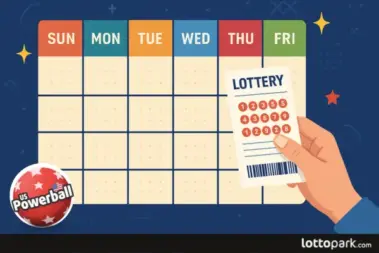
While lottery games are fundamentally based on random chance, statistical analysis of historical data reveals fascinating patterns about when jackpots are most frequently won. Understanding these trends can help players make more informed decisions about when to participate in their favorite lottery games.
Understanding Lottery Drawing Schedules
Different lotteries operate on various schedules, creating multiple opportunities throughout the week for players to test their luck.
Powerball operates on a three-day schedule with draws held every Monday, Wednesday, and Saturday at 10:59 PM ET. Players can buy Powerball tickets online for all three weekly draws.
Mega Millions follows a twice-weekly format, conducting draws every Tuesday and Friday at 11:00 PM ET. With 2025 already delivering some of the biggest Mega Millions wins in history, each draw holds the potential to transform lives.
EuroMillions maintains its traditional Tuesday and Friday drawing schedule at approximately 8:45 PM CET in Paris, France, while EuroJackpot operates on the same Tuesday and Friday schedule at 8:00 PM CET in Helsinki, Finland.
Statistical Analysis: Which Days Produce More Winners?
Recent data analysis suggests fascinating patterns in lottery wins. Action Network’s comprehensive study shows Powerball jackpots are most frequently won on Wednesdays, while Mega Millions jackpots tend to be drawn on Fridays.
Powerball Wednesday Phenomenon
Action Network analyzed Powerball data from 2003 and found that most jackpots—126 in total—were drawn on Wednesday. Monday was the least common jackpot day, with only nine drawings resulting in winners. Players can check Powerball numbers and results immediately after each Wednesday draw to see if the statistical trend continues.
Mega Millions Friday Success
Mega Millions data from 2002 found that Friday is the most common day for jackpot wins, with 119 occurring then. This pattern suggests Friday draws consistently outperform Tuesday draws. Players can verify Mega Millions winning numbers to track winning patterns.
European Lottery Patterns
Both EuroMillions and EuroJackpot draw on Tuesday and Friday, creating natural comparison points for pattern analysis. The consistent Tuesday-Friday schedule across major European lotteries suggests these days are optimal for lottery operations.
Factors Influencing Winning Patterns
Several factors may contribute to observed patterns:
Player Participation Levels: Different days attract varying numbers of players. Weekend draws might see increased casual participation, while mid-week draws attract more regular players.
Ticket Sales Distribution: Higher ticket sales on certain days create larger prize pools and potentially more winners.
Number Selection Patterns: Players may choose different number combinations depending on the day they play.
Understanding Game Rules and Prizes
To make informed decisions about when to play, it’s essential to understand each lottery’s structure. Players can learn more about Powerball jackpot mechanics and prize tiers to optimize their gaming strategy.
Practical Implications for Players
Understanding statistical patterns doesn’t guarantee winning, but can inform strategic decisions. Players should maintain consistent participation across all drawing days rather than focusing solely on “lucky” days.
Regular monitoring of results helps players stay informed about drawing schedules and winning patterns, enhancing the overall gaming experience.
The Science Behind Random Events
While these patterns are statistically observable, lottery draws remain fundamentally random events. Each lottery extraction is independent, meaning past results don’t influence future draws. The patterns observed likely reflect complex interactions between player behavior and lottery operations rather than inherent day-based luck.
Conclusion
Statistical analysis reveals intriguing patterns in lottery wins, with Powerball favoring Wednesday jackpots and Mega Millions showing Friday preference. While these patterns provide valuable insights, successful lottery play depends more on consistent participation within your means and realistic expectations about random chance.
Remember that lottery games are designed for entertainment, and statistical analysis can enhance understanding without changing the fundamental randomness that ensures every ticket has equal winning chances.






